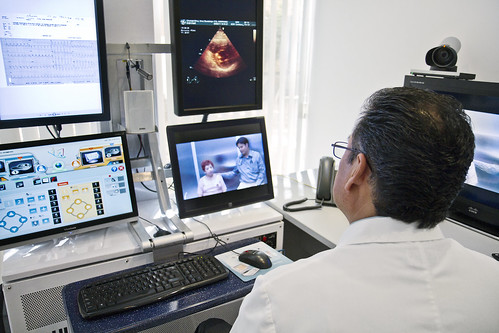A 2012 Washington Post article pointed out that “access to mental health professionals is worse than for other types of doctors: 89.3 million Americans live in federally designated Mental Health Professional Shortage Areas.” Today, widespread access to adequate mental health care is still more of a dream than a reality. Telemedicine may play a large role in ameliorating this problem. What is telemedicine’s role in mental health, how is it helping, and what does the future hold?
An Overview of Telemedicine and Mental Health

Image via Flickr by IntelFreePress
Telemedicine, simply put, is the use of technology to provide patients with services remotely. Physicians, nurse practitioners, and specialists may use video conferencing and long-distance diagnostic techniques to treat and coach patients in rural areas. Telemedicine also provides a way for doctors to monitor their patients’ progress from a distance.
The application for mental health services is clear. Counsellors, psychologists, and psychiatrists can use technology to carry out therapy sessions. Counsellors, psychologists, and psychiatrists can use technology to carry out therapy sessions similarly to how medical doctors use technology to provide medical assessment and consultation.
One professor of psychology, quoted in an American Psychological Association (APA) article, points out one of the dangers of ignoring the advent of telemental health services. She says, “By insisting that patients come to our offices, we’re excluding potentially millions of patients who need care.”
Telemedicine and Mental Health Today
Today’s mental health treatment initiatives continue to strive to make it easier for patients to get access to needed care. Current events in Indiana illustrate these efforts. Speaking to Modern Healthcare, Family and Social Services Secretary John Wernert pointed out that the state has struggled to provide adequate mental health services. Senator Greg Taylor believes that telemedicine is a way to mitigate the problem.
Doctor on Demand, a startup in San Francisco, is also joining efforts to make telemedicine more widely available. The service provides patients with connections to primary care doctors via remote communication methods. Late last year, Doctor on Demand added 300 psychologists and psychiatrists to its network of medical professionals.
Nationwide Children’s Hospital provides another example of how healthcare providers can make use of telemental health services. The hospital recently partnered with a university to provide remote counseling services for children.
The Future of Telemedicine and Mental Health
Certainly, telemental health services still face some problems. While this model helps mental health professionals reach more patients, it does not change the fact that there is still a need for these professionals across the country.
Furthermore, some patients may still hesitate to reach out for mental health services even if they can receive treatment remotely. Stigmas may hold potential patients back, or they may fear that their conversations aren’t private online. The latter concern is not much of an issue in reality, since telemedicine must adhere to HIPAA standards, meaning that conversations are encrypted and kept confidential.
By itself, technology cannot meet the need for greater availability of mental health services. Technology, however, can certainly contribute to the solution. The future may see telemental health growing ever more prominent as care providers look for way to help as many patients as possible.
